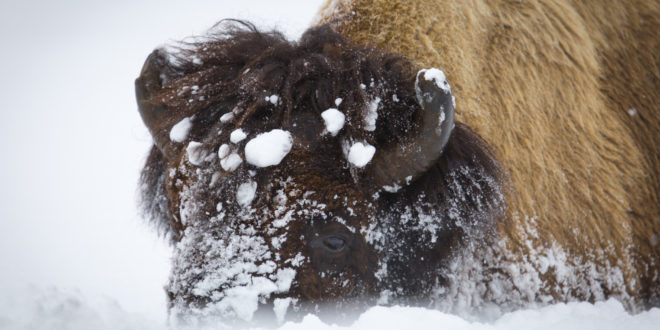A federal judge has ruled the federal government must review whether Yellowstone bison warrant protection under the Endangered Species Act.
The ruling is a triumph for the coalition of environmental and animal rights groups who filed the suit nearly a year-and-a-half ago.
According to the Bozeman Daily Chronicle, a judge in the U.S. District Court in Washington D.C. sided with the Buffalo Field Campaign, Western Watersheds Project and Friends of Animals in their suit against the U.S. Fish and Wildlife Service (USFWS).
We previously reported the coalition had decided to sue the USFWS after the agency rejected two petitions for Yellowstone bison to become a protected series. The groups filed suit in September, following the mandatory 60-day waiting period.
According to the Chronicle, the judge’s opinion held that the USFWS “ignored scientific research relating to the subpopulations of bison in Yellowstone, and whether one or both might warrant protections.”
The USFWS now has 90 days to review this information and issue a new finding.
In a news release, BFC director Ken Cole called the decision “a huge victory.”
The ruling continues a pattern of courts decisions against the USFWS for singling out subpopulations for delisting. Last year, the agency announced it would review its decision to delist Yellowstone grizzly bears. That decision came after a federal court ruled the agency had erred in removing protections for gray wolves around the Great Lakes, arguing the agency had not adequately considered how removing protections for some wolves would impact gray wolves as a whole.
After the USFWS’ announcment re: grizzly bears, the coalition of environmental and animal rights groups suing the USFWS asked the presiding judge to invalidate the agency’s grizzly decision, calling for protections be restored immediately.
Yellowstone National Park is home to the largest population of wild bison in the United States currently, all descended from the millions who once wandered continental North America. After being nearly extirpated from the continent and driven to extinction, bison have bounced back. At last count, approximately 4,800 bison were living in Yellowstone as of summer 2017.
However, outside park boundaries, Yellowstone bison are heavily managed, with bison killed by hunters or rounded up for slaughter each winter under the Interagency Bison Management Plan. Meat and hides from slaughtered bison are distributed among participating tribal agencies and tribal members make up a large number of hunters who come to northern Yellowstone each winter.
Enacted in 2000, the IBMP calls for Yellowstone bison numbers to be reduced and for bison to be prevented from roaming far outside Yellowstone for fear they will spread brucellosis to cattle.
Brucellosis can cause abortions in cattle and necessitates costly measures to quarantine or slaughter infected cattle.
There has never been a documented case of bison-to-cattle brucellosis transmission. Further, recent research points to elk as the main culprits of brucellosis infection among cattle.
In recent years, environmental and conservation groups have called on cattle producers to start managing for brucellosis, including preemptively vaccinating their cattle. Yellowstone has also pushed for allowing bison to be quarantined in the park and cleared of brucellosis; under this program, bison would ideally be allowed to leave the park and possibly shipped to places like the Fort Peck Indian Reservation, which has expressed interest in receiving Yellowstone bison.
Bison slaughter, as well as quarantine, is a point of controversy for many environmental/animal rights groups, which see it as cruel and unnecessary. Indeed, just last month, 52 bison being quarantined at Stephens Creek escaped through a fence cut with a bolt cutter. So far, they have not returned to Stephens Creek and the park has no plans to round them up.
If Yellowstone bison are granted endangered species protections, bison management in Yellowstone (and nationwide) would likely change significantly.
 Yellowstone Insider Your Complete Guide to America's First National Park
Yellowstone Insider Your Complete Guide to America's First National Park





